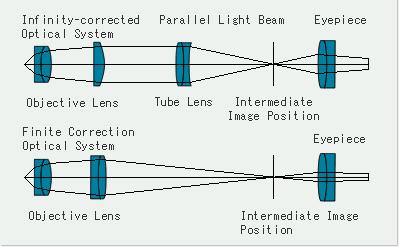Idealopticalsystem
Theidealopticalsystemisanimagingsystemthatcanproduceaclear,completelysimilarimagetotheobject.Thebeamsinwhicheachlightrayoritsextension
linesallintersectatthesamepointarecalledconcentricbeams.Aftertheincidentconcentricbeampassesthroughtheidealopticalsystem,theoutgoingbeammustalsobeaconcentricbeam.Theintersectionoftheincidentandoutgoingconcentricbeamsiscalledtheobjectpointandtheimagepoint,respectively.Theidealopticalsystemhasthefollowingproperties:①Afterallthelightrayscrossingtheobjectpointpassthroughtheopticalsystem,theoutgoinglightraysareallcrossingtheimagepoint.viceversa.Thepointatwhichthispairofobjectimagescanbeinterchangediscalledtheconjugatepoint.②Eachstraightlineontheobjectsidecorrespondstoastraightlineontheimagesidecalledaconjugateline;thecorrespondingsurfaceiscalledaconjugatesurface.③Anyplaneperpendiculartotheopticalaxis,itsconjugatesurfaceisstillperpendiculartotheopticalaxis.④Forapairofconjugateplanesperpendiculartotheopticalaxis,thelateralmagnificationisconstant.Thetheoryofstudyingtheone-to-onecorrespondencebetweenthetwoobjectsinanidealopticalsystemiscalledGaussianoptics.ItwasfirstclarifiedbytheGermanscientistC.Gaussinhisworkin1841.Infact,thereisnotrulyidealopticalsystem.Thecoaxialsphericalsystemcanapproximatelymeettherequirementsofanidealopticalsystemunderparaxialconditions.
Basepointandbasesurface
Severalpairsofspecialpointsandsurfacesthatdeterminetheconjugationrelationshipbetweentheobjectandimageofanidealopticalsystem.
Focusandfocalplane
Thepointontheopticalaxisthatisconjugatetotheinfinityimagepointiscalledtheobjectfocus(orthefirstfocus).AsF;thepointontheopticalaxisthatisconjugatetotheinfinityobjectpointiscalledtheimage-sidefocalpoint(orsecondfocalpoint),andisdenotedasF'.TheplanespassingthroughtheFandF′pointsandperpendiculartotheopticalaxisarecalledtheobjectfocalplane(firstfocalplane)andimagefocalplane(secondfocalplane).
Principalpointandprincipalsurface
Apairofconjugatesurfaceswithalateralmagnificationequalto1iscalledtheprincipalsurface,andtheintersectionofthetwoprincipalsurfacesandtheopticalaxisiscalledMainpoint.AnylightrayemittedfromthefocusoftheobjectF,afterpassingthroughtheopticalsystem,becomesarayparalleltotheopticalaxis.ExtendthepairofconjugatelightraystogettheirintersectionpointM,thisintersectionpointThesetof,constitutesthemainsurfaceoftheobject(thefirstmainsurface),andtheintersectionofthemainsurfaceandtheopticalaxisHiscalledthemainpointoftheobject(thefirstmainpoint).Afterthelightparalleltotheopticalaxisenters,theoutgoinglightintersectsattheimagefocalpointF'.ExtendthepairofconjugatelightraystoobtaintheintersectionpointM'.ThesetofintersectionsconstitutesTheprincipalsurfaceoftheimageside(thesecondprincipalsurface),theintersectionpointH'betweenitandtheopticalaxisiscalledtheprincipalpointoftheimageside(thesecondprincipalpoint).Thetwoprincipalsurfacesareapairofconjugatesurfaces,andthetwoprincipalpointsareapairofconjugatepoints.Theheightofanypairofconjugatepointsonthetwomainsurfacesfromtheopticalaxisisequal,andthelateralmagnificationis1.
Nodesandnodalplanes
Apairofconjugatepointswithanangularmagnificationof1ontheopticalaxisiscalledanode,whichpassesthroughthenodeandisperpendiculartotheopticalaxis.Thefaceiscalledthesectionface.
Object-imagerelationship
InGaussoptics,thespecificopticalsystemisabstractedasasystemconsistingofabasepointandabasesurface.Theobjectdistance,imagedistanceandfocallengthareallbasedontwomainpointsCalculatedasabenchmark.ObjectpointQandobjectfocusFtothemainobjectpointHdistancesandfrespectivelytheobjectdistanceandtheobjectfocallength;theprincipalpointoftheimagesideH'totheimagepointQ'andthefocuspointoftheimagesideF'Thedistancesaretheimagedistances'andtheimagesidefocallengthf'.Thepositionalrelationshipbetweenobjectsandimagesisexpressedbythefollowingformula:
f'/s'+f/s=1
ThisformulaiscalledGaussianformula.Thepositionofobjectsandimagescanalsoberepresentedbyxandx'.Therelationshipbetweenthetwois:
xx'=ff'
ThisformulaiscalledNewton'sformula.
Magnification
Theratiooftheconjugatequantityrelatedtotheobjectandtheimage.Itcanbedividedintothreetypes:horizontalmagnification,verticalmagnificationandangularmagnification.
Horizontalmagnification
Theratiooftheimageheighty'totheobjectheighty,alsoknownastheverticalaxismagnification.βmeans:
β=y'/y=-ns'/n's
wherenandn'aretherefractiveindexoftheobjectspaceandtheimagespace.
Longitudinalmagnification
Theratioofthelongitudinaldepthoftheimagealongtheopticalaxistothelongitudinaldepthoftheobjectontheopticalaxis,expressedbyα.Therelationshipbetweenαandβis:

α=β2n'/n
Angularmagnification
Theanglebetweentheemittedlightandtheopticalaxisu'andtheincidentTheratiooftheangleubetweenthelightandtheopticalaxis,expressedbyγ,namely:
γ=u'/u=tanu'/tanu=ny/n'y'
Therefore:
n'y'u'=nyu
ThisistheLagrange-Helmholtztheorem.
Thethreemagnificationshavethefollowingrelationship:
αγ=β
Aperture
Anopticalelementthatrestrictsthelightbeampassingthroughtheopticalsystem.Itcanbetheframeoftheopticalelement(lens,mirror,etc.)itself,oritcanbeanadditionalopaquescreenwithholes.Thecenterofthediaphragmisusuallyontheopticalaxisandperpendiculartotheopticalaxis.
Eachopticalpartoftheopticalsystemisdefinedbyitsownlensframetodefineitslight-passinghole.Inmostcases,itisaroundhole.Sometimesfixedorvariablededicatedlightholesareaddedtothesystem.Amongalltheselightholes,onelightholemustplayaroleinlimitingtheapertureangleoftheon-axispointimagingbeam;anotherlightholeplaysaroleinlimitingtheimagingrange.Suchanapertureiscalledadiaphragm:theformeriscalledanaperturediaphragmoraneffectivediaphragm;thelatteriscalledafielddiaphragm.Anyopticalsystemmusthavesuchtwodiaphragms.
Aperturediaphragm
Amongthemultiplediaphragms,thelimitingeffectonthebeamisthegreatest,thatis,thediaphragmthatdeterminesthesizeoftheimagingbeam,alsoknownastheeffectivediaphragm.Theaperturediaphragmcanblockthelightthatdeviatesfromtheparaxiallightinthebeam,whichhasadirectimpactonthesharpness,accuracy,brightnessanddepthoftheimage.
Becausetheimagingbeamoftheon-axispointislimitedbytheaperturediaphragm,itiseasytoimaginethatwhenallthelightholesofthesystemareimagedintheobjectspacethroughtheopticalpartsinfrontofit,theon-axisobjectpointisopened.Theimagewiththesmallestangle,ortheimagewiththesmallestaperturewhentheobjectisatinfinity,mustbetheaperturestop.Theimageoftheaperturediaphragmintheobjectspaceiscalledtheentrancepupil,anditsopeningangletotheobjectpointiscalledthebeamapertureangleoftheobjectside.Similarly,theaperturediaphragmisformedintoanimageintheimagespacebytheopticalpartsbehindit,calledtheexitpupil.Itmustalsobeanapertureimagewiththesmallestopeningangleoftheimagepointontheaxis,andthisopeningangleisthebeamoftheimageside.Angleofaperture.Theentrancepupil,aperturestopandexitpupilareconjugated.Ifthediaphragmaberrationisneglected,theentrancepupilisthecommonentranceoftheimagingbeamatallpointsontheobjectplane;theexitpupilisthecommonexitoftheimagingbeam.Thelightpassingthroughthecenteroftheaperturediaphragmiscalledthechiefray,andbecauseoftheconjugaterelationship,italsopassesthroughthecenteroftheentrancepupilandthecenteroftheexitpupil.Therefore,itisgenerallysaidthatthechiefrayisthecenterlineoftheimagingbeam.
Thepositionoftheaperturediaphragmintheopticalsystemisrelatedtomanyfactors.Insomesystems,therearespecificrequirements.Forexample,theexitpupilofthevisualopticalsystemmustbelocatedoutsidetheeyepiecesothatthepupiloftheeyecancoincidewithit;inthetelecentricsystem,theaperturestopshouldbelocatedatthefocalpoint.Inaddition,thepositionoftheaperturestopisalsorelatedtotheaberrationcorrectionandthelateralsizeoftheopticalpartsofthesystem,andshouldbereasonablydeterminedduringdesign.
Fielddiaphragm
Thediaphragmthatdeterminestherangeofvision.Thefielddiaphragmcandeterminethesizeofthefieldofview.Thefielddiaphragmformedbythefrontopticalsystemiscalledtheentrancewindow,andtheimageformedbytherearsystemiscalledtheexitwindow.
Thefielddiaphragmisalightholeintheopticalsystemthatdeterminesitsimagingrange.Insystemswithintermediaterealimageplanes(suchasKeplertelescopesandmicroscopes)andsystemswithrealimageplanes(suchasphotographicsystems),thefielddiaphragmissetonthisimageplane.Theimageofthefielddiaphragmintheobjectspaceformedbytheopticalpartsinfrontofitiscalledtheentrancewindow.Theangleitopenstothecenteroftheentrancepupilisthesmallestofallapertureimages,andthisangleiscalledthefieldangle.Similarly,theimageformedbytheopticalpartsbehindthefielddiaphragmintheimagespaceiscalledtheexitwindow.Theentrancewindow,fielddiaphragmandexitwindowarealsoconjugate.Whenthefielddiaphragmissetontherealimageplaneortheintermediaterealimageplane,theentrancewindowandexitwindowarecoincidentwiththeobjectplaneandtheimageplanerespectively,andthefieldofviewhasaclearboundaryatthistime.Insituationswherethereisnorealimageorintermediaterealimageplane,suchaswhentheeyeisobservingthroughamagnifyingglassorGalileotelescope,thereisalwaysapartinthesystem.Itsclearapertureplaysaroleinlimitingthefieldofview.Theapertureofthetelescopeobjectivelensisthefielddiaphragmthatdeterminestherangeofthevisiblefieldofview.Obviously,theincidentwindowdoesnotcoincidewiththeobjectplaneatthistime,andthereisnoclearboundaryofthefieldofview.
Relativeaperture
TheratiooftheobjectivelensdiameterDtothefocallengthfintheimaginginstrument.Thephysicalquantityusedtodescribethelight-gatheringabilityoftheobjectivelens,becausetheluminousfluxdensityontheimagesurfaceisproportionalto(D/f)2.Thereciprocaloftherelativeapertureiscalledtheaperturefactor,orFnumber.Thephotographiclensisequippedwithanadjustablediaphragm(commonlyknownastheaperture),whichisusedtoadjusttherelativeaperturesize,therebyadjustingtheluminousfluxdensityonthephotosensitivefilm.AseriesofFnumbersareengravedonthelens.WhentheFnumberisreducedby2-1/2timesoftheoriginalvalue,theluminousfluxdensitywillincreaseby2times.ThegeneralFnumberseriesvaluesare
1,1.4,2,2.8,4,5.6,8,11,16,22,...
Thevaluesoftheabovefilesarecalculatedbythefollowingformula(Roundedup):11
Aperturefactor(Fnumber)=(21/2)x
xisapositiveinteger,calledtheindexoftheaperturecoefficient,alsocalledtheAVvalue.IntheaboveF-numberseries,thevaluesoftheadjacenttwogearsdifferby2times,thecorrespondingluminousfluxdensitydiffersby2times,andtheAVvaluediffersbyonelevel.
VignettingPhenomenon
Underidealcircumstances,thebeamsattheon-axisandoff-axispointsarelimitedbytheaperturediaphragm,andhavebasicallythesamebeamapertureangle.IfthefieldofviewNottoobig,theimagesurfaceilluminanceoftheentirefieldofviewisbasicallyuniform.However,inactualopticalsystems,theoff-axispointimagingbeamisoftenlimitedbythelight-passingholesofotheropticalparts.Asaresult,thebeamangleoftheoff-axispointismuchsmallerthanthatoftheon-axispoint.Thisisbecausewhentheoff-axispointisalsoimagedwithabeamoflightthatfillstheentrancepupil,thoselensesthatarefarfromtheaperturestopneedtohavearelativelylargediameter,anditisverydifficulttocorrectforthefull-apertureoff-axisbeam.Therefore,inordertoimprovetheimagingqualityoftheoff-axispointandthelateralsizeoftheopticalpartsisnotparticularlylarge,themethodofappropriatelyreducingcertainlensdiametersisoftenusedtolimittheoff-axislightbeam.Thisphenomenoninwhichthelightbeamfromtheoff-axispointthatfillstheentrancepupilispartiallyinterceptedbysomeopticalpartsandcannotpassthroughtheopticalsystemiscalledbeamvignetting.Thefarthertheoff-axispointisfromtheopticalaxis,themoreserioustheinterceptionphenomenon(thatis,vignetting),andtheresultisthattheimagesurfaceilluminanceattheperipheryofthefieldofviewisgreatlyreduced.Ofcourse,mostopticalsystemsallowacertaindegreeofvignetting.
Imagingbeam
Theimagingbeamofanobjectpointisaspatiallightconewiththeobjectpointasthevertexandtheentrancepupilasthebase.Afterthebeampassesthroughtheopticalsystem,itsstructurewillchange.Foraxisymmetricopticalsystems(mostsystemsbelongtothiscategory),theon-axispointbeamalwayshassymmetricproperties,buttheoff-axispointbeamlosessymmetryafterpassingthroughthesystem.Inordertofacilitatetheunderstandingofthestructureofthisbeam,theplanebeamonthetwocharacteristicsurfacesisusuallyusedfordescription.
Theplanecontainingtheoff-axisobjectpointandtheopticalaxisiscalledthemeridianplane.Duetotheaxisymmetricnatureoftheopticalsystem,off-axisobjectpointscanalwaysbetakenonthedrawingplane,thatis,thepaperplaneisthemeridianplane.Thebeamlyingonthemeridianplaneiscalledthemeridianbeam.Obviously,thechiefraymustbearayinthemeridianbeam.
Theplanecontainingthechiefrayandperpendiculartothemeridianplaneiscalledthesagittalplane.Thebeamlyingonthesagittalplaneiscalledthesagittalbeam.Obviously,thechiefrayistheintersectionofthemeridianplaneandthesagittalplane.Sincethechiefraychangesitsdirectionbytherefractionandreflectionofeachsurfaceofthesystem,thesagittalplanealsochangesfacebyfaceinsteadofaunifiedplane.
Duetotheaxialsymmetryoftheopticalsystem,theon-axisspotbeamdoesnotneedtobeseparatedfromthemolecularmeridianbeamandthesagittalbeam,andtheoff-axisspotbeammustbesymmetricaltothemeridianplane.
Aberration
Theimageformedbythelens(orlensgroup)isnotexactlysimilartotheoriginalappearance.Becausetheangleofthelightemittedbytheobjectpointandthemainaxisofthelensistoolarge,itisfarawayfromtheaxis,ortherefractiveindexofthelensmaterialchangeswiththewavelengthofthelight.Thesizeofaberrationreflectstheprosandconsofimagingquality.Therearemainly7kindsofaberrations;formonochromaticlight,thereare5kinds,namely,sphericalaberration,coma,astigmatism,curvatureoffieldanddistortion.Forpolychromaticlight,therearetwokindsofchromaticaberrations,namelyaxialchromaticaberrationandverticalchromaticaberration.Eliminatingorreducingtheseaberrationsasmuchaspossibleisanimportanttaskinthedesignofopticalsystems.
Symmetricalcoaxialdrawing
Thepropertiesofsymmetricalcoaxial
①Theobjectpointontheopticalaxis,theimagepointisalsoOntheopticalaxis;②Theobjectpointinthesectionpassingtheopticalaxisiscoplanarwiththeimage;③Thepropertiesofanysectionpassingtheopticalaxisarethesame;④Aplaneperpendiculartotheaxishasthesamemagnificationinthesameplane;⑤Knowingthepositionandmagnificationoftwopairsofconjugatesurfaces,orknowingthepositionandmagnificationofapairofconjugatesurfaces,plusthetwopairsofconjugatepointsontheopticalaxis,candeterminetheimagingoftheidealopticalsystem.
Proofbydrawingmethod
①Thepositionandmagnificationoftwopairsofconjugatesurfacesareknown.Thepositionandmagnificationoftheconjugatesurface,aswellasthepositionsofthetwopairsofconjugatepointsontheaxis,areshownasfollows:
